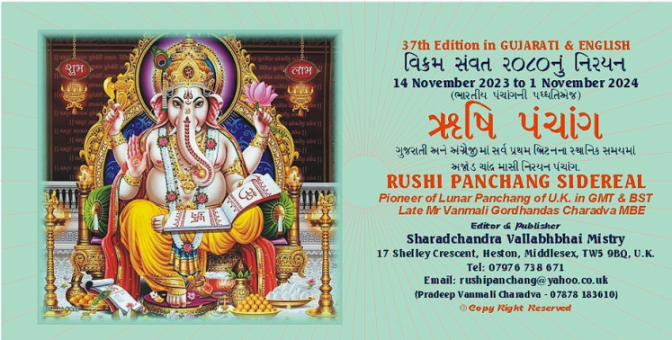|
Shree Ganeshai Namah
Jai Mataji,
Shravan month starts on 5 August 2024.
Introduction
The Hindu festivals, fasts, rituals, holy baths and the observance of sacred days are part and parcel of the great cultural heritage. They are religious and social and a great source of spiritual and moral enrichment. They also lend zest, variety, colour and grandeur to an otherwise insipid, routine and care-worn day-to–day human existence. The Hindu festivals are more than what they appear to be. They are essentially a way of living and thinking in the course of existence, and as such bring their whole right to bear on the individual and the society.
Unlike the deities of the Hindu pantheon, the festivals are numerous and frequent, but basically religious, psychological and intimately connected with the changes of seasons, though many of them have lost the history of their origin in the mists of hoary past. With passage of time they have undergone a process of transformation and evolution and many new festivals have been grafted upon the old ones.
A Hindu festival is, in fact, something more than a ‘festival’. It is cathartic in nature, and as a means of purification strengthens the spirit within. Their goal is to find enjoyment through renunciation and self-denial. They are more of an exploration of the colourful things of life, without being bound to or obsessed by them.
Why do we require panchang for different cities (Countries)?
Most people buy the Panchang from India and use it everywhere in the world. This is not a good practice and one could lead to people observing festivals on incorrect days and at incorrect times abroad. Each festival has a different set of rules about when to observe them. Hindu festivals are generally based on the Tithi and/or Nakshatra as per the lunar calendar (& some as per the solar calendar). For example, Ganesh Chaturthi is Bhadrapad Shukla Chaturthi Madhyahn purvavidha vyapini (4th tithi prevailing at midday). Each tithi begins and ends at the same instant all over the world. After correcting for the time zones, the tithi will begin/end at different local times in different parts of the world. The next thing is to decide if the tithi is visible during the specified time. This is done by using local sunrise, local sunset and local moonrise times. Since India has little variation in terms of sunrise/sunset, a panchang computed for one area of the country is generally usable throughout the country. For example - on a given day if Chaturthi end time is 2:30pm in India. Hence, UK will observe the chaturthi end time of 9:00am (GMT). This clearly indicates in the United Kingdom that the Chaturthi tithi is not prevailing during madhyahan kal (noon time) but it does prevail in India. Hence, the UK will celebrate Ganesha chaturthi on the previous day, as the chaturthi prevails during the noon on the previous day (chaturthi start time is 9:30am GMT in the UK.). What is important is to observe the festival at the right time in your location. If you blindly use the Indian calendar published in India, it won’t be any good to you as the festival observance dates might change due to local sunrise, sunset, moonrise, time differences etc. The panchang available in India only prints end times in Indian standard times (IST). You need to convert them to your local standard time and use local sunrise and sunset to find out when it can be observed. Most common mistakes people make is observing Pradosh and Ekadashi vrat on incorrect days by following the Indian panchang printed in India.
Gujarati GCSE Classes online. (Pearson Edexcel GCSE 9-1 - See below for details).
This month’s main Panchang Details.
17-07-2024 Dev Shayani Ekadashi, Chaturmaas starts, Saurashtri Molakat begins 18-07-2024 Pradosh 19-07-2024 Jayaparvati Vrat & Gujarati Molakat begins 20-07-2024 Chaumasi Chaudash (Jain), Vrat Purnima 21-07-2024 Guru Purnima, Aashadhhi Purnima, (Purnima until 11:17), Vyas Puja, Sanyasi Charturmas beging, Saurashtri Molakat Jagaran 22-07-2024 Hindola begins, Saurashtri Molakat Parna 23-07-2024 Jayaparvati and Gujarati Molakat Jagaran (3rd Kshaya Tithi UK) 24-07-2024 Sankasht Chaturthi, Moon rise 22:47 25-07-2024 Naag Panchami - Lohanani and Bengalni 27-07-2024 Kalashtami 31-07-2024 Kamika Ekadashi 01-08-2024 Pradosh, Lokmanya Tilak Punya date 02-08-2024 Shivratri 03-08-2024 Darsh Amavashya 04-08-2024 Deep Puja, Deevaso & Avrat Jivrat Jagaran, Moon set 21:22, Amas until 12:13
05-08-2024 Shravan month begins, Shiv Puja (with Rice), Chandra Darshan Beejna 06-08-2024 Mangla Gauri Puja 09-08-2024 Naag Panchami, Jivantika Pujan, Agasti Darshan 10-08-2024 Randhan Chhath, Kalki Jayanti 11-08-2024 Sheetla Satam 12-08-2024 Durga Ashtami, Shiv Puja (with Seaseme seeds) 13-08-2024 Noli Nom (south Gujarat), Nikul Nom, Mangla Gauri Puja, (9 Vruddhi Tithi UK) 15-08-2024 Putrada, Pavitra Ekadashi-Smart UK, Bharat Independence Day, (11 Kshaya Tithi UK), Parsi san 1394 begins, Parsi 1 Farvardin, New Year begins, Pateti begins 16-08-2024 Pavitra Barash, Jivantika Pujan 17-08-2024 Shani Pradosh 19-08-2024 Vrat, Naliyeri Purnima, Shravani Purnima, Balev, Raksha Bandhan from 9:03, Shiv Puja (with Moong), Hyagriva Jayanti, Avni Jayanti (S. India)
REFERENCE:
If you would like a copy of the Rushi Panchang please call 07976 738671 for further details. or email at Rushi.Panchang@gmail.com
-------------------------------------------------- (Website Contact Email: pyg_hounslow@hotmail.com) _________________________________________
LIST OF IMPORTANT HINDU FESTIVALS & VRATS FOR U.K. Important Note:The Hindu festivals are generally based on a certain Tithi (roughly translated as the lunar phase) or the Nakshatra (Position of Asterisms with respect to the moon and the earth) in a given month or the transition of other heavenly bodies. When the time and place differ a lot from the place for which the Panchang (Religious Almanac) is computed the occurrence of the festival on a given day could change. To correctly compute the time and date of a festival, one must compute the Tithi, Nakshatra etc. for that place in terms of the local time of that place. The festival celebration times and days/dates listed here are calculated according to local UK times and these may differ from other places in the world (e.g. India, USA).
The above auspicious times are calculated according to the Leicester, UK co-ordinates Latitude 52N38 and Longitude 1W05. ___________________________________________________
Lunisolar Almanac:
Lunisolar months are lunar months and based upon the appearance of the moon. Interestingly there are two kinds of lunisolar months too.
_______________________________________________________ |
News from Vidyasagar School
We have started the GCSE Gujarati Classes online via Zoom.
For further details please contact -
Sharad Mistry - 07976 738671 (GCSE)
(Gujarati Classes are held on ZOOM, every Monday and Tuesday evening)
(School Email: vidyasagar_school@hotmail.com)

